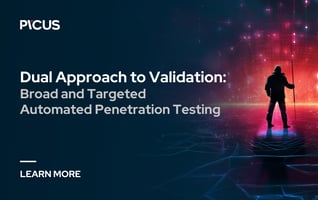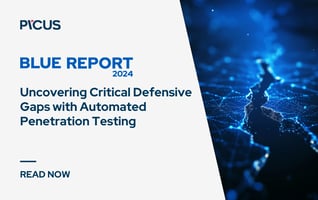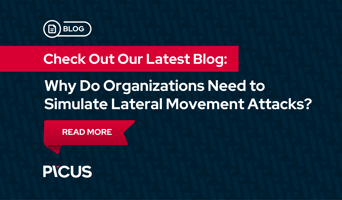What Is An Attack Path?
An attack path is a sequence of interconnected steps an attacker can take to move through an organization’s IT environment and achieve a specific objective. This objective can include gaining domain admin access or deploying ransomware. It often begins with reconnaissance, where the attacker gathers information about systems, users, and configurations to identify initial access points. From there, they chain together security vulnerabilities and misconfigurations to pivot to other endpoints and expand their control within the environment.
Understanding attack paths is essential for modern defense planning. Security professionals must differentiate between attack vectors, attack surfaces, and attack paths to effectively reduce exposure and improve resilience. While these concepts are often used interchangeably, each plays a distinct role in modeling and mitigating cyber risk.
In this blog, we explore their differences and highlight why attack path validation is critical for identifying and managing real-world threats across the attack lifecycle.
Why Understanding Attack Paths Are Important To Cyber Security
Understanding attack paths is essential to cybersecurity because adversaries rarely rely on a single isolated weakness. Instead, they combine multiple exploitable exposures to progress through the environment and reach critical assets. Traditional security assessment tools often fail to reveal how these issues connect and escalate risk. This is where attack path validation and management plays a critical role. It identifies how misconfigurations, exposed credentials, excessive access rights, and privilege escalation techniques can combine to form real attack scenarios.
By validating the exploitability of attack paths in an organization’s directory environment, such as Windows Active Directory, security teams can focus on what truly matters. They can prioritize the most dangerous attack vectors that lead to the organization’s crown jewels (e.g. your domain admin accounts). This helps reduce risk more effectively.
This proactive approach enhances threat detection, improves response readiness, and supports a stronger, more resilient security posture.
What Stages Do Attackers Go Through In An Attack Path?
Attackers navigate through a dynamic series of stages in an attack path, adapting their actions based on what they discover at each step to progress toward their objective.
Step 1: Initial Access (a.k.a infiltration point): In Active Directory environments, attackers often begin by compromising a domain-joined user account. This initial foothold provides them with trusted access within the internal network, enabling interactions with other systems and facilitating reconnaissance activities.
Step 2: Enumeration and Reconnaissance: Attackers commonly use techniques such as LDAP queries to gather information about users, groups, and configurations, which aids in planning subsequent lateral movements and privilege escalations.
Each newly accessed endpoint triggers recon to uncover users, sessions, privileges, ACLs, and misconfigurations. Recon is repeated at every stage, as results can vary depending on privilege level and host context. Therefore, it's common to observe privilege escalation attempts at multiple points during an attack, as attackers adapt to the changing context and seek to achieve their objectives.
Step 3: Credential Access (if applicable): If recon identifies a Kerberoastable user, for example, attackers may extract the service ticket and crack it offline to obtain the plaintext password.
|
Credential access techniques such as Pass-the-Hash, LSASS memory dumping, and Kerberoasting are critical tools for attackers aiming to escalate privileges and move laterally within a network. These methods allow adversaries to dump stored or cached credentials, often without needing the plaintext password, enabling them to impersonate legitimate users and access sensitive systems. By leveraging these techniques, attackers can bypass traditional authentication mechanisms, maintain persistence, and expand their control over the environment. |
Step 4: Privilege Escalation: Elevating privileges on the current host increases process integrity and can reveal more valuable recon data, including access to administrative tools or hidden paths.
Step 5: Lateral Movement: Using harvested credentials, attackers pivot to other systems: such as a machine where the cracked user has admin rights.
Final: Objective Completion: Ends when the goal is reached, such as domain dominance or file server access.
Attack Vector vs. Attack Surface vs. Attack Path
Attack Vector
An attack vector is a specific method used by an attacker to achieve an objective, such as gaining unauthorized access to a system or network, obtaining control of resources, or stealing sensitive information. Some of the most common attack vectors are malware, phishing emails, compromised and weak credentials, misconfigurations, software vulnerabilities, and abusing trust relationships, as in supply chain attacks.
Attack Surface
The attack surface is the set of all possible attack vectors in an organization. An attack vector could allow an adversary to compromise a system or network. However, the attack surface refers to all known, unknown, and potential attack vectors that an attacker could use to compromise systems and networks in an environment.
Attack Surface Analysis
Attack surface analysis is determining an organization’s attack surface by examining possible attack vectors and assessing the likelihood that attackers leverage them to perform malicious actions. As a result of attack surface analysis, the organization knows which attack vectors pose a risk. Then, the organization can increase its cyber resilience by eliminating these vectors. For instance, if a program uses a vulnerable Log4j version on a server that an attacker could exploit, the organization can eliminate this attack vector by applying patches released by the vendor.
What Is Attack Path Discovery?
Attack path discovery is the process of identifying all the possible routes an attacker could take to move through an organization’s IT environment and reach critical assets. Rather than analyzing exposures in isolation, it focuses on how misconfigurations, weak privileges, and credential issues can be chained together to form viable attack paths.
However, discovery alone is not enough. There is no effective tool that performs meaningful attack path discovery without also delivering automated penetration testing capabilities. To understand which paths are truly exploitable, discovery must be combined with validation. This is why attack path validation and management must be delivered together within a single product. Such a solution not only identifies attack paths but safely simulates real attacker behavior and presents the results in a graph based format to support clear analysis and prioritization.
|
The attack path discovery process can begin from any point a security professional chooses to simulate, depending on the scenario they want to assess. For instance, automated pentesting technologies realistically mimic the steps an attacker would take starting from a single domain joined user. Teams can simulate what would happen if the CEO or another key decision maker clicks a phishing email and determine how many steps it might take for an attacker to deploy ransomware across the domain environment. This flexibility allows for targeted and realistic risk assessment. As a result, it leads to more efficiently allocated and mobilized remediation efforts. |
This process reveals not just individual risks, but how those risks combine into full attack chains, helping security teams understand where attackers could go and how to stop them.
What Is Attack Path Mapping?
Attack path mapping is the process of organizing and visualizing the sequence of steps an attacker could take to move from an initial foothold to a critical asset within a network. After discovering exposures, the system connects them into coherent multi-step paths, linking misconfigurations, privilege relationships, and credential weaknesses.
As new endpoints are reached, mapping is updated in real time to reflect evolving context and new findings.
The goal is to show how attackers can progress laterally and escalate privileges, not just in theory but in the actual environment. This helps security teams understand the potential impact of vulnerabilities when combined with others to form real attack chains. It provides defenders with a clear view of potential breach scenarios, helping them prioritize which paths to block or break first.
What Is Attack Path Visualization?
Attack path visualization is a graph based way to represent how attackers move through a network. In this model, endpoints are shown as nodes and the connections between them, along with the techniques used for access such as credential abuse or privilege escalation, are shown as edges.
This visual map makes it easy to trace full attack paths from an initial access point to high value targets like domain admin.
Figure. An Arbitrary Attack Simulation Result from Picus Attack Path Validation (APV)
It also helps identify choke points, which are shared steps across multiple paths. By addressing these choke points, security teams can break several attack chains at once and reduce overall exposure more effectively.
Attack Path Analysis
Attack Path Analysis is a process designed to uncover the potential paths attackers could exploit to compromise an organization's infrastructure. By systematically identifying weak points across systems, applications, and configurations, organizations can gain a comprehensive understanding of how an adversary might move laterally through their environment to reach sensitive assets or disrupt operations.
The process of Attack Path Analysis begins with pinpointing critical assets, such as proprietary data, financial systems, or intellectual property, and mapping realistic threat scenarios based on known vulnerabilities and attacker behaviors. Security teams analyze the organization's attack surface, tracing how an intruder could progress from an initial foothold to a valuable target. This includes examining misconfigurations, unpatched systems, insufficient access controls, and other exploitable gaps.
Unlike traditional vulnerability assessments that often produce overwhelming lists of isolated risks, Attack Path Analysis connects the dots to show how individual weaknesses combine to form exploitable chains. By visualizing these interconnected attack paths, organizations can prioritize their defense strategies more effectively.
Attack Path Management
Attack Path Management is the continuous process of discovering, visualizing, validating, and eliminating the paths attackers could use to move through an organization’s IT environment and reach critical assets. It builds on the foundation of attack path analysis but turns it into an ongoing practice rather than a one-time assessment.
With each change in the environment, such as new users, systems, or exposures, attack paths can shift. Attack Path Management helps track and respond to these changes continuously. When combined with Automated Penetration Testing, both capabilities can work together within the same platform provided by a single vendor. The platform runs safe and realistic attack simulations across the directory environment to validate which paths are actually exploitable. This allows security teams to focus on fixing the exposures that matter most and break the attack chains that pose the highest risk.
It helps security teams understand how exposures interact, focus remediation on shared choke points, and ensure that protections stay effective over time. The goal is to shrink the attack surface continuously and prevent attackers from chaining weaknesses into successful breaches.
Attack Path Validation
Attack Path Validation is the process of identifying, analyzing, mapping, managing, and validating attack paths that attackers could take to reach their goals within the network. Therefore, it covers attack path discovery, attack path analysis, attack path mapping, and attack path management processes.
Attack path validation is critical for understanding the real cybersecurity risk faced by organizations. It exposes the steps an attacker would likely take to compromise your network, such as exploitation of vulnerabilities, lateral movement within a network, privilege escalation, and stealing critical information.
Attack Path Validation allows you to eliminate attack paths within a production environment. Once you know where the risks exist, you can start to address them through technical, procedural, and policy means, as well as by building an end-to-end risk-based defense.
Benefits of Attack Path Validation
Attack Path Validation provides organizations with a clear, continuous, and actionable view of the risks that exist within their internal networks. By not only identifying but also validating attack paths, it offers a more accurate understanding of how an attacker could move through an environment to compromise critical assets.
Unlike traditional vulnerability scanning or occasional penetration tests, which often produce isolated findings, Attack Path Validation reveals how individual vulnerabilities and misconfigurations can be chained together to enable full attack scenarios. By seeing the complete attack paths, security teams can prioritize remediation efforts more effectively and implement defensive measures where they are needed most.
Attack Path Validation vs. Vulnerability Scanning
What distinguishes Attack Path Validation is its ability to identify new and unknown chains of attack vectors that reach critical assets within the network, as opposed to just individual attack vectors in signature-based attack analysis approaches such as vulnerability scanning. As a result, attack paths more accurately depict your attack surface and help you better prepare for potential threats. Moreover, a vulnerability scanner only identifies vulnerabilities, whereas the Attack Path Validation approach goes much further by exploiting identified vulnerabilities and creating validated Attack Paths that demonstrate how attackers can exploit the vulnerabilities and connections between the assets within the network to reach their utmost objectives.
Attack Path Validation vs. Internal Network Penetration Testing and Red Teaming
Since most organizations are focused on defending their external attack surface, they are unaware of possible attack vectors within their networks and how attackers might exploit them to achieve their goals. Some security teams engage in internal network penetration testing and red teaming to increase the visibility of post-compromise attack vectors. However, due to limitations in both time and resources, these types of assessments are neither thorough nor performed frequently enough to be functional for continuous improvement in cyber resilience. As a result, they do not provide the level of insight necessary for continuously identifying, prioritizing, and mitigating risks.
Picus Attack Path Validation
Picus’s Attack Path Validation (APV) product is a comprehensive attack path analysis, mapping, and management solution that offers all the previously explained benefits of the attack path validation approach and more.
With Picus Attack Path Validation, security teams can automatically discover and visualize the steps an advanced attacker that has successfully breached a network would likely take to compromise critical assets and entities, such as domain admin credentials and the Domain Controller (DC) server in the Active Directory (AD).
Powered by Picus’ Intelligent Adversary Decision Engine, which mimics the approach and actions of real-world adversaries, this easy-to-use application identifies, validates, and helps eliminate the attack paths that pose the most significant risk. By doing so, Picus Attack Path Validation
-
reveals truly critical and urgent to resolve attack vectors, vulnerabilities, and misconfigurations that are a part of a validated attack path,
-
exposes assets and entities attackers could discover and exploit to achieve their objectives, and
-
provides mitigation and remediation actions focused on ensuring the greatest impact.
Therefore, the user can concentrate on remediating and mitigating the riskiest threats and spare the time and effort of fixing a long list of unprioritized vulnerabilities and attack vectors that are not necessarily exploitable by attackers.
Picus Attack Path Validation: Identifying and Eliminating Exploitable Attack Paths
Picus Attack Path Validation (APV) operates like a skilled adversary inside your environment. It does not stop at identifying isolated vulnerabilities, it reveals how those weaknesses can be chained together to simulate real attacker behavior. Whether the attacker’s objective is financial gain or disruption, APV validates how far they could get after gaining an initial foothold. To illustrate this, we created a real-world simulation against a fictional organization named Valhalla Corp.
Below is a step-by-step breakdown of how Picus APV identifies and validates a full attack path to domain dominance.
-
Initial Access: The simulation begins with user ardis.cassie on a domain-joined machine WKSTN16.
-
Credential Discovery: APV identifies diane.bird as a Kerberoastable user.
-
Kerberoasting: APV extracts Diane’s encrypted service ticket and cracks it offline to obtain her plaintext password.
-
Privilege Escalation: On WKSTN16, APV performs a User Access Control (UAC) bypass to elevate ardis.cassie’s privileges.
-
Lateral Movement: Session enumeration reveals that diane.bird has administrative rights on WKSTN26. APV uses her credentials to create an implant session on that system.
-
Credential Dumping: On WKSTN26, APV dumps credentials from LSASS and obtains the MsCache hash of cicely.llewellyn.
-
New Pivot: Enumeration shows cicely.llewellyn has admin rights on SRV02. APV uses her credentials to access the system.
-
Hash Cracking and Escalation: APV cracks cicely.llewellyn’s hash to get the plaintext password and performs another LSASS dump on SRV02.
-
Domain Admin Access: APV extracts NTLM hashes of derick.ortega, who is confirmed to be a domain administrator.
In just seven steps, Picus APV demonstrates how an attacker can escalate from a single compromised user to complete domain control. This simulation highlights the most critical steps an attacker would take post-breach, providing security teams with clear, validated actions to prioritize and remediate.
How Picus APV Is the Strongest Remediation Guide?
Picus APV does more than just simulate how attackers move. It reveals exactly which exposures make those movements possible and offers precise, technical remediation guidance based on real attack paths, not theory. Rather than overwhelming teams with thousands of disconnected issues, Picus highlights the few critical exposures that, when fixed, can break entire attack chains.
For example:
Kerberoastable User Identified: Picus APV detects diane.bird as a Kerberoastable user. Instead of a generic recommendation, it advises:
-
Enforcing long, complex passwords on service accounts—making them computationally infeasible to crack (estimates suggest a 25-character password with complexity could take over 50 years to break).
-
Regularly rotating service account passwords, for instance every 90 to 120 days, so even if credentials are obtained, they quickly become useless.
-
Restricting service accounts from logging in interactively or laterally moving across the environment.
Weak Privilege Escalation Paths: When APV shows a UAC bypass was used, it may recommend:
-
Disabling auto-elevation for high-integrity processes where not needed.
-
Implementing Credential Guard to protect against credential theft from LSASS.
-
Auditing and minimizing local administrator rights across endpoints.
Shared Admin Access: If a single user, like cicely.llewellyn, has administrative access to multiple high-value systems, APV highlights the risk of lateral movement and suggests:
-
Segmenting admin roles across systems to reduce blast radius.
-
Implementing Just-in-Time (JIT) access to minimize permanent administrative privileges.
Every recommendation is grounded in real attacker behavior observed in the simulation. This makes remediation not only more focused but also more impactful. Instead of guessing what to fix, security teams can confidently address exposures that matter most, based on validated risk.








